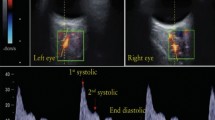Abstract
Objective
To determine the clinical value of uterine artery Doppler Pulsatility index (PI) at 22–24 + 6 weeks scan and importance of maternal history and mean arterial pressure (MAP) in the prediction of pre-eclampsia.
Materials and Methods
This was a prospective screening study of 200 women with singleton pregnancy. Maternal history and blood pressure were recorded, and MAP was calculated. Transabdominal Doppler ultrasound of uterine artery was performed. Mean PI was calculated, and the presence or the absence of bilateral early diastolic notch was noted. Women were then followed up through pregnancy and delivery for the development of pre-eclampsia, gestational hypertension, and SGA.
Results
The mean ± SD PI value for subjects who had an adverse pregnancy outcome was significantly higher (0.84 ± 0.28) than mean ± SD PI value for subjects who had normal pregnancy outcome (0.71 ± 0.16) with P value <0.000.
Conclusion
Second trimester uterine artery Doppler is a useful screening method for identification of high risk pregnancy in women who can be kept under close surveillance for better maternal and neonatal outcome. This test works better when combined with previous history of pre-eclampsia and MAP.

Similar content being viewed by others
References
Onwudiwe N, Yu CKH, Poon LCY, et al. Prediction of pre-eclampsia by a combination of maternal history, uterine artery Doppler and mean arterial pressure. Ultrasound Obstet Gynecol. 2008;32:877–83.
Ohkuchi A, Minakami H, Sato F, et al. Predicting the risk of pre-eclampsia and small for gestational age infant by quantitative assessment of the diastolic notch in uterine artery flow velocity waveforms in unselected women. Ultrasound Obstet Gynecol. 2000;16:171–8.
Zimmermann P, Eiri Ö, Koskinen J, et al. Doppler assessment of the uterine and uteroplacental circulation in the second trimester in pregnancies at high risk for pre-eclampsia and/or intrauterine growth retardation: comparison and correlation between different Doppler parameters. Ultrasound Obstet Gynecol. 1997;9:330–8.
Espinoza J, Romero R, Jyn KN, et al. Identification of patients at high risk for early onset and/or severe pre-eclampsia with the use uterine artery Doppler velocimetry and placental growth factors. Am J Obstet Gynecol. 2007;96(4):326.01–13.
Cnossen S, Morris RR, Gerben R, et al. Use of uterine artery Doppler Sonography to predict pre-eclampsia and intrauterine growth restriction: a systematic review and bivariable meta-analysis. CMAJ. 2008;178(6):701–11.
Cnossen JS, Joris AM, Khalid SK, et al. Prediction of pre-eclampsia: a protocol for systematic reviews of test accuracy. BMC Pregnancy Childbirth. 2006;6:29.
Papageorghiou AT, Yu CKH, Bindra R, et al. Multi-center screening for pre-eclampsia and fetal growth restriction by trans-vaginal uterine artery Doppler at 23 weeks of gestation. Ultrasound Obstet Gynecol. 2001;18:441–9.
Plasencia W, Maiz N, Poon L, et al. Uterine artery Doppler at 11 + 0 to 13 + 6 weeks and 21 + 0 to 24 + 6 weeks in the prediction of pre-eclampsia. Ultrasound Obstet Gynecol. 2008;32:138–46.
Aardema MW, De Wolf BTHM, Saro MCS, et al. Quantification of the diastolic notch in Doppler ultrasound screening of uterine arteries. Ultrasound Obstet Gynecol. 2000;16:630–4.
Yazici FG, Tok E, Gulhan S, et al. Relationship of early diastolic notch in uterine artery Doppler measurements with pregnancy complications in low risk pregnancies. Perinatal J. 2005;13:152–7.
Gomez O, Figueras F, Fernadez S, et al. Reference ranges for uterine artery mean pulsatility index at 11–41 weeks of gestation. Ultrasound Obstet Gynecol. 2008;32:128–32.
Aardema MW, Saro MCS, Lander M, et al. Second trimester Doppler ultrasound screening of the uterine arteries differentiates between subsequent normal and poor outcomes of hypertensive pregnancy: two different pathophysiological entities. Clin Sci. 2004;106:377–82.
Harrington K, Goldfrad C, Carpenter R, et al. Transvaginal uterine and umbilical artery Doppler examination at 12–16 weeks and the subsequent development of pre-eclampsia and intrauterine growth retardation. Ultrasound Obstet Gynecol. 1997;9:94–100.
Palma-Dias RS, Mercedes MC, Brietzke E, et al. Screening for placental insufficiency by transvaginal uterine artery Doppler at 22–24 weeks of gestation. Fetal Diagn Ther. 2008;24:462–9.
Author information
Authors and Affiliations
Corresponding author
Rights and permissions
About this article
Cite this article
Prajapati, S.R., Maitra, N. Prediction of Pre-Eclampsia by a Combination of Maternal History, Uterine Artery Doppler, and Mean Arterial Pressure (A Prospective Study of 200 Cases). J Obstet Gynecol India 63, 32–36 (2013). https://doi.org/10.1007/s13224-012-0239-4
Received:
Accepted:
Published:
Issue Date:
DOI: https://doi.org/10.1007/s13224-012-0239-4




